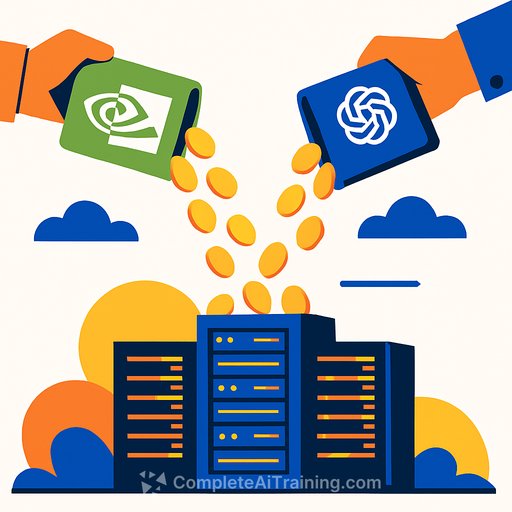Nvidia tightens its grip on AI with up to $100B staged investment in OpenAI
Nvidia and OpenAI announced a staged partnership that could reach $100 billion. This isn't just about chip supply. Nvidia will co-build the compute backbone OpenAI needs, with investments released gigawatt by gigawatt as data centers come online.
The first sites, built on Nvidia's coming Vera Rubin platform, are slated to flip on in the second half of 2026. At full scale, the build reaches 10 gigawatts - roughly the output of several nuclear reactors.
What was announced
The companies said "the details of this new phase of strategic partnership" will be finalized in the coming weeks. It's a letter-of-intent to invest progressively in cash and equity as each gigawatt is deployed - money that shows up alongside concrete, power, racks, and GPUs.
Nvidia becomes OpenAI's "preferred strategic compute and networking partner," aligning hardware and software roadmaps so model releases and silicon land in lockstep. As Nvidia's Jensen Huang put it, the move marks "the next leap forward." OpenAI's Sam Altman framed it simply: "everything starts with compute."
Why it matters for finance
This gives Nvidia multi-year demand visibility: millions of GPUs, high-speed networking, and software licenses across several product generations. The proposed commitment is almost twice Nvidia's fiscal 2024 revenue (~$61B) and on par with its annual capex guidance (~$66-$72B), signaling how central OpenAI is to its pipeline.
Shares of Nvidia rose about 3.5% on the news. Oracle gained roughly 5% midday as investors priced in massive new data-center demand. Expect spillovers to utilities, power equipment, and data-center REITs as the grid and interconnect work becomes a gating factor.
Why it matters for IT leaders and developers
- More predictable capacity: OpenAI can better guarantee API availability and training slots, which reduces bottlenecks for teams building on GPT models.
- Faster cadence: Aligned roadmaps mean model improvements can ship closer to silicon cycles.
- Vendor concentration: Deeper dependency on Nvidia may sideline alternatives in the near term; portability and multi-cloud strategies deserve renewed attention.
- Energy and interconnect are the real bottlenecks: Turning on 10 GW requires sites, permits, grid access, and power purchase agreements.
Competitive and partner dynamics
Microsoft remains OpenAI's largest investor and primary cloud host, even after recent changes to their cloud arrangement. The partnership "complements" work with Microsoft, Oracle, SoftBank, and the Stargate initiative, pointing to a broad coalition around infrastructure buildout.
Rivals like Amazon and Google - both heavy buyers of Nvidia hardware - may worry about allocation if OpenAI gets first crack at Rubin-era parts. AMD and Intel face the risk of being further marginalized if the next wave of compute is effectively pre-committed to Nvidia platforms.
What could get in the way
- Regulatory scrutiny: A top AI startup teaming with its dominant supplier at this size will draw antitrust questions about preferential access.
- Grid constraints: Interconnection queues, substation builds, and firm energy sourcing could slow timelines independent of funding.
- Execution risk: Delivering millions of accelerators, networking, and cooling across multiple sites without delays is a multi-year operational challenge.
Scale and demand signals
OpenAI cited over 700 million weekly active users and strong enterprise adoption to make the case it can utilize this buildout. For enterprises, that means a steadier supply of tokens and throughput. For consumers, it hints at a quicker upgrade cycle for ChatGPT.
The message is clear: the scarce resource in AI is compute. By committing up to $100B, Nvidia buys certainty, and OpenAI buys time - enough to keep training frontier models at pace.
What to watch next
- Final deal terms and any disclosure on equity, warrants, or revenue commitments.
- Site locations, energy mix, and interconnection timelines for the 10 GW plan.
- Rubin platform milestones and first production deployments in H2 2026.
- How Microsoft, Oracle, and other partners split hosting and networking roles.
- US and EU regulatory reactions to supplier-financed capacity deals.
- GPU allocation impacts on Amazon, Google, and independent labs.
Action steps
- Finance: Reassess exposure to AI infrastructure cycles - semis, optical networking, power equipment, and utilities tied to data-center growth.
- IT leaders: Update capacity plans for GPT-based workloads; align SLAs with expected throughput improvements and consider region diversification.
- Developers: Plan for faster model refreshes; build feature flags to adopt new GPT versions quickly; keep an eye on pricing and rate limits.
- Procurement: Negotiate multi-cloud pathways and GPU reservation options to avoid allocation shocks.
For official updates, monitor the Nvidia newsroom and the OpenAI blog.
If you lead teams across finance, IT, or engineering and want structured training aligned to your role, explore curated programs at Complete AI Training - Courses by Job.
Your membership also unlocks:










